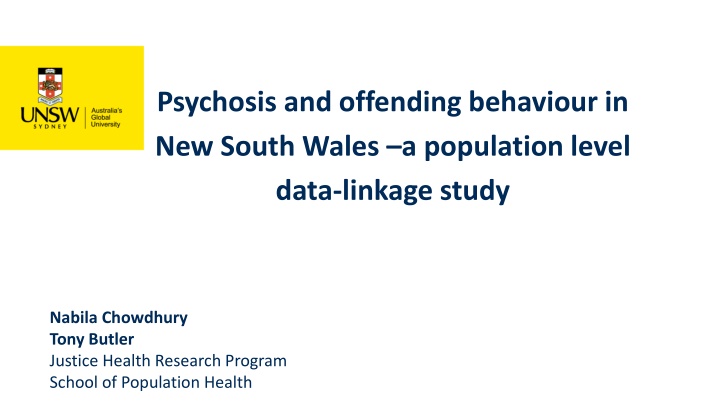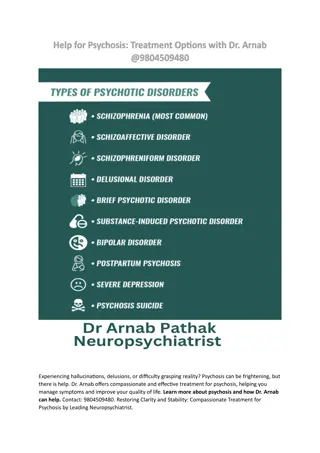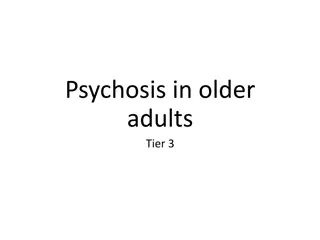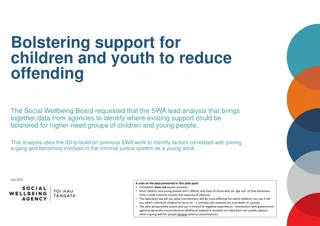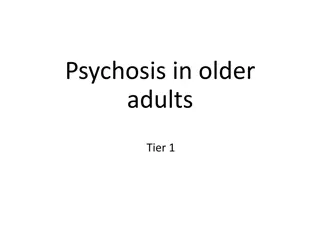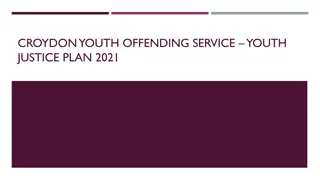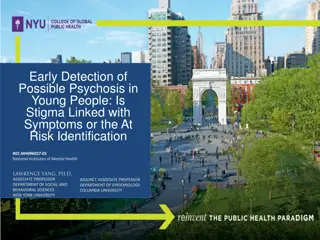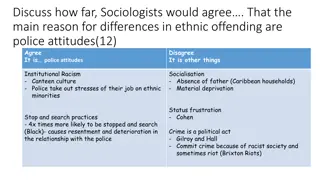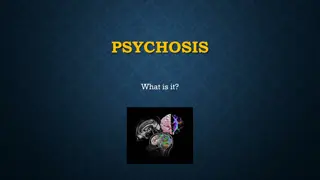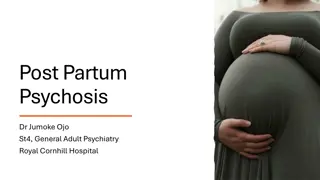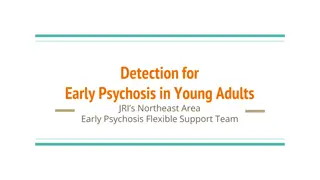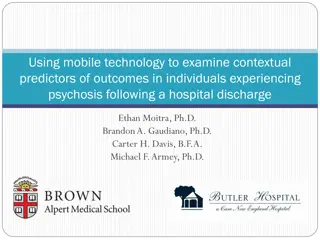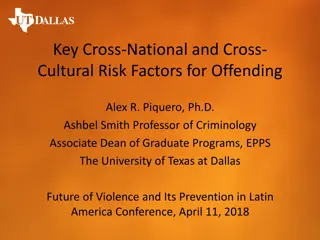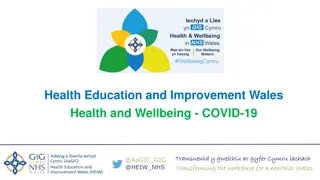Population-level Study on Psychosis and Offending Behavior in New South Wales
Psychosis is a chronic mental illness associated with criminal offending, explored through a data-linkage study in New South Wales. Key findings reveal the prevalence of psychosis in prison samples and its impact on offending behavior, highlighting the need for further research and interventions.
Download Presentation

Please find below an Image/Link to download the presentation.
The content on the website is provided AS IS for your information and personal use only. It may not be sold, licensed, or shared on other websites without obtaining consent from the author.If you encounter any issues during the download, it is possible that the publisher has removed the file from their server.
You are allowed to download the files provided on this website for personal or commercial use, subject to the condition that they are used lawfully. All files are the property of their respective owners.
The content on the website is provided AS IS for your information and personal use only. It may not be sold, licensed, or shared on other websites without obtaining consent from the author.
E N D
Presentation Transcript
Psychosis and offending behaviour in New South Wales a population level data-linkage study Nabila Chowdhury Tony Butler Justice Health Research Program School of Population Health
Acknowledgements A/Professor Stephen Allnutt Conjoint Lecturer, UNSW Psychiatry A/Professor Handan Wand - Kirby Institute, UNSW Australia Dr Azar Kariminia - Kirby Institute, UNSW Australia Dr Armita Adily - Kirby Institute, UNSW Australia Professor Peter Schofield - Hunter New England Local Health District Dale Owens Justice Health & Forensic Mental Health Network Luke Grant - Corrective Services NSW Professor James Ogloff - Swinburne University of Technology Dr Grant Sara - NSW Ministry of Health Dr Elizabeth Moore - NSW Ministry of Health A/Professor Don Weatherburn - NSW Bureau of Crime Statistics and Research Colman O Driscoll - Medibank Professor David Greenberg AM - Justice Health & Forensic Mental Health Network Professor Malcolm Hudson Macquarie University Dr Olayan Albalawi University of Saudi Arabia Dr Erin Spike- Kirby Institute, UNSW Australia
Presentation First Psychosis data linkage study commenced in 2016 Updated data linkage study (2001-2020) Association between psychosis and offending behaviour Recency of diagnosis of psychosis and prison episodes for most recent year (2019-2020) Prison EQUIPS programs, alerts and self-harm inside prison Post release reoffending Role of social housing in post-release contact with community mental health services Mortality in the cohort Future research based on these data
Psychosis Psychosis is a chronic relapsing mental illness characterised by a loss of contact with reality including hallucinations and delusions. Considered to be a risk factor for criminal offending, including violent offending References of papers on offending by psychotic Prevalence higher in prison samples (Odds Ratio = 11.2; Butler & Allnutt 2006)
Key findings from the first Psychosis data linkage study (2001-2015) Association with offending established Cases were 5 times more likely to have a conviction for offending compared to controls Cases - 10% of all offences committed in NSW between 2001 and 2015. Similar offending profiles Diversion (Section 32/33 Mental Health Act) Only 26% of those with a prior diagnosis of psychosis received a treatment order Treatment orders were 50% lower in Aboriginal citizens. Re-offending 12% lower in those with psychosis who received a treatment order versus a punitive sanction. Treatment Increased contact with community mental health services significantly reduced the odds of reoffending (5x greater in those with no clinical contact versus those with the most contact). Early treatment (within 30 days of index offence) reduced the chance of reoffending by 30%.
Kaplan-Meier curves for treatment order versus punitive sanction on re-offending
Updated Data-linkage study (2001-2020)
Data collections 1. NSW Admitted Patient Data Collection (APDC) 2. NSW Emergency Department Data Collection (EDDC) 3. NSW Mental Health Ambulatory Data Collection (MH-AMB) 4. Mental Health Outcomes and Assessment Tool Collection (MH-OAT) 5. NSW Bureau of Crime Statistics and Research Reoffending Database (ROD) 6. NSW Offender Integrated Management System (OIMS)* 7. The NSW Registry of Births, Deaths and Marriages (RBDM) death registrations 8. Australian Bureau of Statistics (ABS) mortality dataset 9. NSW Controlled Drugs Data Collection (CoDDaC)(NEW) 10. Housing Operations Management and Extended Services Database (HOMES) - NSW Dept. of Communities & Justice (NEW) 11. Client Information Management System (CIMS) NSW Dept. of Communities & Justice (NEW) 12. Child Protection database from NSW Dept. of Communities & Justice (NEW) 13. Out of Home Care database from NSW Dept. of Communities & Justice (NEW) 14. NSW Mental Health Review Tribunal database (NEW) * For this study, we received some additional datasets associated with the NSW Offender Integrated Management System (OIMS) along with the custody episodes data i.e., alerts, prisoner movements, in prison programs, self- harm records, LSI-R and ISQ datasets.
Cohort definition Cohort definition Cases: All individuals in NSW diagnosed with psychosis on admission for a hospital episode (APDC), or emergency department (EDDC) between 2001 and 2020, regardless of age (n = 143,506) Controls: For each case, two controls without any record of a diagnosis of psychosis during the study period matched by birth year and sex identified from the CHeReL Master Linkage Key1 (n = 270,848) Focussed on three types of psychosis based on ICD codes: 1. Schizophrenia and related psychoses 2. Affective psychoses 3. Substance-related psychoses 1 Contains around 151 million records of 13 million people and was constructed by the Centre for Health Record Linkage (CHeReL)
Characteristics of the study population Median age of individuals with psychosis was 44 years (IQR: 31-62) at the time of their most recent diagnosis and for controls 46 years (IQR:32-66) 55% of the study population men 6.2% individuals with psychosis were identified as being of Aboriginal heritage compared with 1.7% of controls Cases were more likely to be from disadvantaged areas according to the SEIFA (51.7% vs. 44.3%, p<0.001)
Recency of psychosis diagnosis Recency of psychosis diagnosis 13
Recency of diagnosis of psychosis by year & lifetime diagnosis (all cases) July 2001-June 2020 100.0 6.5 6.6 6.6 6.9 7.2 7.4 7.9 8.6 10.3 10.5 10.7 11.4 13.4 14.4 15.3 15.8 15.9 16.0 16.6 18.3 90.0 11.9 9.8 11.5 13.8 14.4 13.0 14.3 14.6 15.1 80.0 19.3 18.7 19.2 14.8 12.0 14.4 10.1 11.9 11.9 13.5 12.8 70.0 60.0 50.0 82.3 81.6 81.3 40.0 79.6 79.6 79.0 78.8 76.8 73.5 73.3 72.7 72.3 72.1 71.8 71.2 70.6 70.6 70.4 70.3 68.9 30.0 20.0 11.5 10.0 8.4 7.1 6.7 5.9 5.5 5.1 5.0 5.0 4.8 4.7 4.4 4.3 4.3 4.2 4.1 3.1 3.0 2.9 0.0 Lifetime Psychos is 2001- 2002 2002- 2003 2003- 2004 2004- 2005 2005- 2006 2006- 2007 2007- 2008 2008- 2009 2009- 2010 2010- 2011 2011- 2012 2012- 2013 2013- 2014 2014- 2015 2015- 2016 2016- 2017 2017- 2018 2018- 2019 2019- 2020 Substance-related psychoses 10.3 10.5 10.7 6.9 7.4 7.2 6.5 6.6 6.6 8.6 11.4 14.4 13.4 15.9 18.3 16.0 15.3 15.8 16.6 7.9 Affective psychoses 19.3 19.2 18.7 14.3 13.0 11.5 11.9 14.4 13.8 14.6 15.1 14.4 14.8 13.5 12.8 11.9 12.0 11.9 10.1 9.8 Schizophrenia and related psychoses 70.4 70.3 70.6 78.8 79.6 81.3 81.6 79.0 79.6 76.8 73.5 71.2 71.8 70.6 68.9 72.1 72.7 72.3 73.3 82.3 Total yearly % of most recent diagnosis 3.0 2.9 3.1 4.3 5.0 5.1 5.0 4.3 4.4 4.2 4.1 4.7 4.8 5.5 5.9 6.7 7.1 8.4 11.5
Recency of psychosis diagnosis 32.7% had their most recent diagnosis over a decade ago (i.e., cumulative percentages from 2001-2009), 11.5% in 2019-2020, and 8.4% in 2018-2019 etc. Lag between the most recent diagnosis for a treatment episode and incarceration episode may give an indication of current treatment burden of the prisoner population.
Offending behaviour Proportion of offences committed by individuals with psychosis (overall) and controls July 2001-June 2020 Almost one-third of psychosis cases (32.9%) and 6.9% of controls had been convicted of an offence between July 2001 and June 2020 Convictions were highest in those with substance-related psychoses across most offence categories. More than one fifth of the cases (22.2%) and 3.6% of the controls had a conviction for a violent offence The median number of convictions among cases was 10 versus 4 for controls
Prison Episodes Prison Episodes 17
Prison episodes (2001-2020) Overall, 14,900 (10.4%) cases and 2,713 (1%) controls were incarcerated at least once between 2001 and 2020 21.6% cases were Aboriginal vs. 18.0% of controls. Among cases who were incarcerated 18.6% had their most recent prison episode in 2019-2020
Recency of diagnosis of psychosis and prison episodes for most recent year (2019-2020) 991 of 2,779 (35.7%) cases had their most recent diagnosis of psychosis in 2019-2020 and also a prison episode during this time period. A further 239 had a recent diagnosis of psychosis in 2017-2018 and 455 in 2018-2019 Thus, we estimate that somewhere between 5% and 8.8% of the total prisoner population have had a recent (past 3 years) diagnosis of psychosis (considering the total prisoner population of 19,089 in 2019 According to the Australian Bureau of Statistics).
Self Self- -harm in Prison harm in Prison 20
Self-harm incidents in prison Overall, 15.0% of cases who went to prison self-harmed inside prison vs. 3.6% of controls Those with a diagnosis of schizophrenia and related psychoses were 5 times more likely than the controls to have self-harmed in prison. Similarly, those with affective psychoses and substance-related psychoses were also more likely to self-harm Men less likely than women to self-harm Aboriginal people more likely to self-harm Older individuals less likely than those under 25 years to self-harm
Adjusted* odds ratios for self-harm in prison- 2001-2020 * Adjusted by psychosis type, age, sex, and Aboriginality
Prison alerts and self-harm Study population 11,344 cases (had a prior diagnosis before prison episode) and 2,680 controls Alerts during prison episodes 2,066 (18.2%) cases 2,808 alert records 70.1% alerts were mandatory alerts followed by 27.4% alerts for a history of mental illness
Prison Programs Prison Programs 25
Prison programs CSNSW delivers programs including the Explore, Question, Understand, Investigate, Practice, Succeed (EQUIPS) suite of programs: EQUIPS Foundation program EQUIPS Aggression program EQUIPS Addiction program EQUIPS Domestic Violence program Intensive Drug and Alcohol Treatment Program Sex Offender Treatment program Violent Offender Treatment program Education program 2,882 (19.5%) cases commenced or completed at least one program vs. 459 (17.1%) controls
Programs commenced vs. completed in cases (n=14,769) and controls (n=2,680) 2001 - 2020 10.0 Cases Controls 9.2 9.0 8.6 8.5 7.9 7.8 8.0 7.0 6.2 6.0 4.7 5.0 4.3 4.0 3.0 2.4 2.3 2.2 2.0 2.0 1.6 1.5 1.3 1.2 1.2 1.1 1.1 1.0 0.9 1.0 0.6 0.5 0.5 0.4 0.3 0.1 0.0 0.0 0.0 0.0 EQUIPS Foundation program commenced EQUIPS Foundation program completed EQUIPS Aggression program commenced EQUIPS Aggression program completed EQUIPS Addiction program commenced EQUIPS Addiction program completed EQUIPS Domestic Violence program commenced EQUIPS Domestic Violence program completed Intensive Drug and Alcohol Treatment Program commenced Intensive Drug and Alcohol Treatment Program completed Sex Sex Violent Offender Treatment program commenced Violent Offender Treatment program completed Education program commenced Offender Treatment program commenced Offender Treatment program completed
Findings Findings 11,720 cases and 2,109 controls were selected who were released from prison (2001-2018) These individuals were followed-up until their first occurrence of an offence or death or completion of the study period at the end of June 2020 The median follow-up time was 4.5 years (IQR: 2.2-8.6) 66.8% of cases reoffended vs. 59.5% of controls (2001-2020)
Adjusted* hazard ratios for reoffending in prisoners with psychosis released from prison up to June 2018 and followed-up until 2020 * Adjusted for psychosis type, Aboriginality, sex, age, and marital status.
Social Housing following release from prison and contact with community mental health services
Housing database Housed applicants by social housing support Applicants on waiting list to get social housing Housed applicants by other providers 75.3% cases had contact with community mental health services vs. 26.9% of controls
Relationship between stable housing and post-release contact with community mental health services Multivariate logistic regression models were used Reference group- those with no housing record Housed applicants by social housing support (n=1,663; 14.2%) were approximately 3 times more likely to have mental health service contact in the community. Applicants on waiting list (n=1,284; 11.0%) were approximately 2 times more likely to have mental health service contact in the community. Housed applicants by other providers (n=210; 1.8%) were approximately 3 times more likely to have mental health service contact in the community.
Adjusted odds of having post-release contact with community mental health services in released prisoners with a prior diagnosis of psychosis (released up to June 2018 and followed up until 2020)
Results 22.56% (n = 30,838) cases died vs. 11.48% controls (n = 31,819) died between July 2001 to June 2019 schizophrenia and related psychoses (25.5%; n = 26,056); affective psychoses (18.6%; n = 3,383); substance-related psychoses (8.6%; n = 1,399) Cases with no imprisonment history (n = 122,796) were over 2 times more likely to die than controls with no imprisonment history Cases with a history of imprisonment (n = 13,924) were also more likely to die compared with controls with no imprisonment history Controls with an imprisonment history (n = 2,617) were less likely to die compared with controls without an imprisonment history Overall, there were 38 deaths in prison between 2001 and 2019 (35 men, 2 women). 37 had a prior diagnosis of psychosis (28 schizophrenia)! 17 suicide (o Controls; 12 schizophrenia; 1 affective psychosis; 4 substance-related psychosis) 6 individuals were given alert and 3 did self-harm
Conclusions Those with a history of psychosis represent a sizeable segment of the prisoner population. Treatment (contact with mental health services) known to work in reducing recidivism. Most psychosis is unknown to the prison system (alerts). Imprisonment poses a risk of self-harm to those with serious mental illness. Prison programs do not have any effect on reoffending Access to housing appears to improve access to mental health services.
Future research 1. Examine a range of in-prison factors along with social and behavioral factors in relation to psychosis and offending Prison movements data (OIMS) Prison Intake Screening Questionnaire (ISQ) database (OIMS) 2. Examine the following databases NSW Controlled Drugs Data Collection (CoDDaC) Child Protection & Out of Home Care databases 2. Examine the effect of medication use and clinical visits (GPs, psychiatrists, psychologists) on offending for those diagnosed with or without psychosis in NSW using Pharmaceutical Benefits Scheme (PBS) database Medicare Benefits Schedule (MBS) claims data 3. Examine the impact of Mental Health Review Tribunal orders (MHRT database) for civil and forensic patients with psychosis on offending and recidivism rates.
The End The End 39
Publications 1. Chowdhury, N. Z., Albalawi, O., Wand, H., et al. (2021). Psychosis and Criminal Offending: A Population-Based Data-Linkage Study. Criminal Justice and Behavior, 48(2), 157 174. 2. Albalawi O, Chowdhury NZ, Wand H, et al. Court diversion for those with psychosis and its impact on re-offending rates: results from a longitudinal data-linkage study. BJPsych open. 2019;5(1):e9. 3. Hwang YIJ, Albalawi O, Adily A, et al. Disengagement from mental health treatment and re-offending in those with psychosis: a multi-state model of linked data. Social psychiatry and psychiatric epidemiology 2020 doi: 10.1007/s00127-020-01873-1. 4. Adily A, Albalawi O, Kariminia A, et al. Association Between Early Contact With Mental Health Services After an Offense and Reoffending in Individuals Diagnosed With Psychosis. JAMA Psychiatry 2020;77(11):1-10. doi: 10.1001/jamapsychiatry.2020.1255. 5. Chowdhury NZ, Albalawi O, Wand H, et al. First diagnosis of psychosis in the prison: results from a data-linkage study. BJPsych open 2019;5(6):e89-e89. doi: 10.1192/bjo.2019.74. 6. Adily A, Albalawi O, Sara G, et al. Mental health service utilisation and reoffending in offenders with a diagnosis of psychosis receiving non- custodial sentences: A 14-year follow-up study. Australian & New Zealand Journal of Psychiatry. 2022;0(0). doi:10.1177/00048674221098942. 7. Simpson, P. L., Settumba, S., Adily, A., Ton, B., & Butler, T. (2021). Defining optimal post-prison care for those with psychosis: A Delphi study. Front Psychiatry, 1796. 8. Chowdhury NZ, Wand H, Albalawi O, Adily A, Kariminia A, Allnutt S, Sara G, Dean K, Ellis A, Greenberg D, Schofield PW, Butler T. Mental health service contact following release from prison or hospital discharge in those with psychosis. Front Psychiatry. 2022 Dec 15;13:1034917. doi: 10.3389/fpsyt.2022.1034917. PMID: 36590622; PMCID: PMC9798427. 9. Weatherburn, D., et al., Does mental health treatment reduce recidivism among offenders with a psychotic illness? Journal of Criminology, 2021. 54(2): 239-258. DOI: 10.1177/0004865821996426. 10. McDonald, et al. Who gets diverted into treatment? A study of defendants with psychosis. Journal: Psychiatry, Psychology and Law. 2023. https://doi.org/10.1080/13218719.2023.2175070
